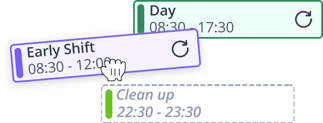This article breaks down what mid shift hours are, which industries use them, their benefits, challenges, and how to implement them strategically within your organisation.
What are mid shift hours?
Mid shift hours refer to work periods that typically start in the late morning or early afternoon and extend into the evening. These shift schedules are designed to bridge the gap between the traditional day shift (usually starting around 8 or 9 a.m.) and the night shift (often beginning at 10 or 11 p.m.).
Instead of the usual 9-to-5, a mid shift might start at 11 a.m., 12 p.m., or even 2 p.m., and end around 7 p.m. to 10 p.m. The goal is to align shift start times with peak demand in the workplace, particularly in businesses that operate across a broad part of the day or across multiple time zones.
Common time frames for mid shifts:
|
Shift Type |
Typical Start Time |
Typical End Time |
Purpose |
|---|---|---|---|
|
Day Shift |
7:00 – 9:00 a.m. |
3:00 – 5:00 p.m. |
Core business hours |
|
Mid Shift |
11:00 a.m. – 2:00 p.m. |
7:00 – 10:00 p.m. |
Covers peak periods and transitions |
|
Swing Shift / Second Shift |
2:00 – 4:00 p.m. |
10:00 p.m. – 12:00 a.m. |
Overlaps with late activity |
|
Graveyard Shift/ Third Shift |
10:00 – 12:00 a.m. |
6:00 – 8:00 a.m. |
Overnight operations |
This shift pattern is commonly used in industries where extended periods of operation are needed, but full 24/7 coverage isn’t essential. Mid shift hours often avoid the early morning rush and the fatigue associated with the graveyard shift, making them a more balanced option for both employers and employees.
Benefits of mid shift hours for employers
Mid shifts can significantly boost productivity, help teams align with real business needs, and reduce unnecessary costs.
Operational efficiency
Mid shift hours are especially useful for managing peak periods when customer demand, service load, or operational intensity is at its highest.
-
Shifts starting in the late morning or afternoon ensure proper coverage during busy hours without overwhelming morning or night teams.
-
Helps maintain smooth workflow during lunch and dinner rushes in hospitality, or visitor spikes in retail.
-
Supports shift pattern optimisation, avoiding overlap or underutilisation of employees.
By spacing out shift start and end times throughout the day, companies can avoid bottlenecks and evenly distribute responsibilities across teams.
Employee satisfaction
Not every worker thrives on early mornings or late nights. Mid shift hours give more flexibility, helping to improve employee well being.
-
Ideal for team members with personal commitments like school drop-offs, caregiving, or part-time studies.
-
Encourages better work life balance, especially for those who struggle with 12 hour shifts, graveyard shifts, or split shift schedules.
-
Can lead to higher job satisfaction, lower absenteeism, and improved retention.
Cost-effectiveness
Well-planned mid shifts allow employers to use resources more efficiently, reducing unnecessary costs.
-
Less need for overtime if workloads are covered during high-demand periods.
-
Avoids duplication of labour across two separate shifts by strategically placing staff in midday slots.
-
Makes better use of scheduling software to manage shift lengths, staff breaks, and time tracking accurately.
Challenges associated with mid shift hours
While mid shifts can be powerful for the organisation, they also come with a few challenges that need careful management.
Scheduling complexities
Creating fair shift schedules that balance business needs and employee preferences isn’t always straightforward.
-
Managers must juggle shift times, team availability, and working hours regulations.
-
Some teams may need to rotate between day, mid, and evening shifts, complicating roster creation.
-
Use of automated scheduling tools can help reduce bias and errors.
Here’s a quick comparison:
|
Scheduling Factor |
Traditional Shifts |
Mid Shifts |
|---|---|---|
|
Start Times |
Fixed (e.g., 9–5) |
Varies (11 a.m. – 2 p.m.) |
|
Shift Overlap |
Minimal |
Requires planning |
|
Flexibility |
Limited |
Higher |
|
Scheduling Complexity |
Lower |
Moderate to high |
Employee adaptability
Not all workers will be comfortable switching to or working mid shift hours.
-
Some may find it difficult to adjust their routines, especially if they’ve worked day shift for years.
-
Transport or childcare options may not align well with mid shift start or end times.
-
Communication and gradual adjustment can help teams adapt more easily to new work schedules.
Compliance with labour laws
Regardless of shift timing, compliance is non-negotiable.
-
Employers must respect legal limits on working hours, mandatory rest breaks, and maximum weekly hours.
-
Break times must be scheduled appropriately within the shift period, especially during extended shifts.
Best practices for implementing mid shift hours
Rolling out mid shift hours successfully requires clarity, strategy, and people-first thinking.
Assessing operational needs
Before you introduce a mid shift, make sure it actually serves your business goals.
-
Analyse when your peak shift times occur; review customer activity, service logs, or foot traffic.
-
Identify which departments need support outside the traditional day shift or second shift hours.
-
Monitor current shift lengths, idle time, and overtime costs to pinpoint inefficiencies.
Employee consultation
Getting employee preferences on board early can smooth out the process and boost job satisfaction.
-
Share the reasoning behind mid shift proposals; use team meetings or surveys to gather feedback.
-
Ask employees which shift start and end times would suit their personal commitments.
-
Setup trial shifts and involve team leads or supervisors to help test different types of shift schedules before rolling them out widely.
Transparent communication
Once the plan is in motion, keep everyone in the loop with clear and consistent updates.
-
Set expectations for shift roles, responsibilities, and rotation (if any).
-
Document key details: shift period, length, rest breaks, and overtime policies.
-
Use visual shift calendars, internal portals, or workforce apps to help teams manage their availability and shifts.
Legal considerations
When introducing mid shift hours you also need to ensure your approach aligns with employment laws in your region.
US regulations
US federal labour laws don’t regulate exact shift start or end times, but they do set rules for working hours, breaks, and overtime pay.
Key legal points to consider:
-
Fair Labor Standards Act (FLSA): Requires overtime pay for non-exempt employees who work more than 40 hours a week, regardless of whether it's a day shift, mid shift, or night shift.
-
Meal and rest breaks: Not mandated federally, but many states (e.g. California, Washington) require:
-
A 30-minute unpaid meal break for shifts over 5 hours
-
Paid 10-minute rest breaks for every 4 hours worked
-
-
Split shift premiums: In certain states, if an employee works two separate shifts in a day (e.g., with a gap in between), they may be entitled to additional pay.
Employers must also ensure that shift lengths and rotations don’t result in excessive working hours or compromise employee well being.
UK regulations
In the UK, mid shift hours fall under the Working Time Regulations 1998, which set out specific protections for all workers, including those on flexible shifts, afternoon shifts, or swing shifts.
Key requirements include:
-
Maximum weekly working hours: Cannot exceed 48 hours on average (usually calculated over 17 weeks), unless the employee opts out.
-
Rest breaks:
-
At least 20 minutes for every shift longer than 6 hours
-
11 consecutive hours of rest between shifts
-
At least one full day off per week (or two every 14 days)
-
-
Night work: Special rules apply if any part of the shift falls between 11 p.m. and 6 a.m., including health assessments and working time limits.
Useful Read: What Actually Counts as ‘Working Time’ For Paid Breaks and Split Shifts?
How Shiftbase simplifies mid shift scheduling
Managing mid shift hours can get complicated, especially when you're juggling employee preferences, labour law compliance, and fluctuating shift times. This is where Shiftbase steps in to make life easier.
With Shiftbase, you can:
-
Build smarter employee scheduling templates that adapt to mid, split, and rotating shifts.
-
Use real-time time tracking to monitor who’s clocking in for afternoon or evening shifts.
-
Handle absence management effortlessly, even across overlapping hour shifts or 12 hour shifts.
-
Give employees visibility over their own shift schedules, boosting satisfaction and reducing conflicts.
From healthcare teams to customer support centres, Shiftbase helps you manage different types of shifts with ease, accuracy, and full legal alignment.
👉 Start your free 14-day trial today and simplify how you manage mid shift hours: Try Shiftbase for free

- Create rosters quickly
- Insight into labor costs
- Access anywhere via the app



